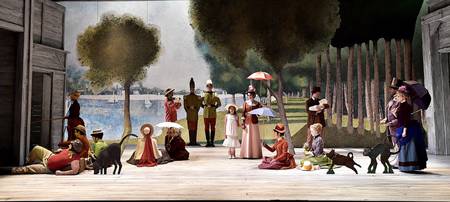Musical (1984)
Music and lyrics by Stephen Sondheim
Book by James Lapine
Directed by Peter DuBois
Huntington Theatre Company
Boston University Theater
Symphony Hall area, Boston
September 9 – October 16, 2016
Choreographer: Daniel Pelzig; Music Director: Eric Stern; Scenic Design: Derek McLane; Costume Design: Robert Morgan; Lighting Desing: Chrstopher Akerlind; Sound Design: Jon Weston; Projection Design: Zachary G. Borovay; Orchestrations: Michael Starobin
With Adam Chanler-Berat (George), Jenni Barber (Dot, Marie), Bobbie Steinbach (an old lady, Naomi Eisen), Amy Barker (her Nurse, Harrie Pawling), Josh Breckenridge (Jules, Billy Webster), Aimee Doherty (Yvonne, Blair Daniels), Todd A. Horman (a boatman, Charles Redmond), Morgan Kirner (Celeste #1), Sarah Oakes Muirhead (Celeste #2, Betty), Bailey MacNeal or Margot Anderson-Song (Louise), Patrick Varner (Franz, Alex), Melody Butiu (Frieda, a man lying on the bank, Elaine), Andrew O’Shanick (a soldier, young man sitting on the bank, bartender), James Andrew Walsh and Amy Barker (Mr. and Mrs.), Nick Sulfaro (Louis, boy bathing in the river, Dennis), Jessica Kundia (Woman with baby carriage, waitress), Jordan McLaughlin (Man with bicycle, hornplayer, photographer), James Andrew Walsh (Bob Greenberg), Morgan Kirner (Lee Randolph)

Photo: Paul Marotta
Courtesy of Huntington Theatre Company
In this charming musical and imagistic romp, Stephen Sondheim envisions the creation of Seurat’s great painting by placing the painter on the Parisian island of La Grande Jatte and populating it with all the people that figure into that Post-Impressionist classic. Primary among these is Dot, the figure who dominates the painting and whom Sondheim imagines as Seurat’s unfulfilled lover.
Though the romantic tale between George (Adam Chanler-Berat) and Dot (Jenni Barber) fills out the guts of the first part of the work, the primary theme is art-making – what it means to perfect a vision and to bring it to fruition. It is also about the loneliness of the artist and the frustrations of unfulfilling forms of success.
The second half of the show takes place in the contemporary art world with George (Adam Chanler-Berat), the similarly named great-grandson of the painter, taking center stage with his grandmother (Jenni Barber) who is Dot’s daughter. It’s a cute pretension that brings things to the present and ties it all together.
This show, though sweet in many ways, is one of Sondheim’s abstract ones. More like Sondheim’s Assassins (1990) and Pacific Overture (1976), it is a kind of idea play, a musing on a theme that has its compelling aspects but which also has a kind of conceptual drive behind it. Other of Sondheim’s greats – A Little Night Music (1973) and Sweeney Todd (1979) – have more vividly down-to-earth stories. Any production of this show must contend with its inclination towards that kind of abstractness.
The current production is very tight and well put together. The orchestra and the singing are carefully done and the staging is pretty interesting.
There is something, however, which feels a bit attenuated at times, perhaps as a result of the extreme care with which it has been rendered. That carefulness sometimes seems to draw away from the sense of artistic urgency that the musical itself seems, in an underlying way, to want to convey.
One might well argue that the urgency that lies at the heart of the artist’s sensibility is thwarted not by the production but by the character of Seurat who tends towards austerity and withdrawnness.
When, in the second act, the contemporary George emerges, there is some greater sense of that urgency and turmoil, which gives a bit more drama to its unfolding. Even so, however, there seemed to be a kind of spacious remove at times even then, which suggests something about the well-oiled but perhaps somewhat a bit too cautious approach to the underlying energy.
As Dot, and then as Marie, Dot’s grandmother, Jenni Barber does a great job. She has a real comedienne’s sensibility, and especially as Dot in the first act, makes a lot of entertaining gag-like gestures. When she becomes the old lady in the second part, she completely and wonderfully transforms.
Adam Chanler-Berat as Seurat has a quietude and austerity that prevails in the first part and then, as George, Seurat’s great-grandson, opens up in a more visceral way in the second part. His first act number Finishing The Hat, about completing parts of his painting, and Putting It Together in the second part, truly the mirrored anthems of the show, are highly effective. Chanler-Berat doesn’t have a big voice but he has phrasing and articulation down in a convincing way.
Sets are simply but persuasively done. A sliding frame pulled onto the stage early on includes a tableau of another Seurat classic, Bathing at Asnières (1883), done with live actors in a funny and charming way. In the first part of the show, the tableau of characters making up the dramatization of the painting of Sunday Afternoon on La Grande Jatte is beautifully and movingly staged, albeit momentarily. In the second part, projected photo of the contemporary island of Grande Jatte fills the stage and dramatically sets the scene for what ensues there.
– BADMan
Leave a Reply